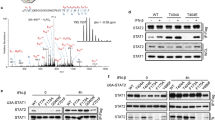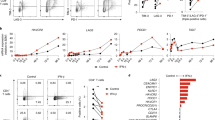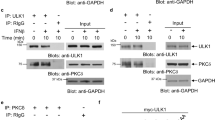Abstract
Signal transduction through both cytokine and lymphocyte antigen receptors shares some common pathways by which they initiate cellular responses, such as activation of mitogen-activated protein kinase(s)1,2. However, other signalling components appear to be uniquely coupled to each receptor. For example, the interferon receptors transduce regulatory signals through the JAK/STAT pathway, resulting in an inhibition of growth and of antiviral effects, whereas this pathway apparently plays no role in T-cell-receptor (TCR)-dependent gene expression3,4. Conversely, signal transduction through the TCR requires the tyrosine kinases Lck and ZAP-70 and the tyrosine phosphatase CD45 (ref. 5). Here we show that, unexpectedly, transmission of growth-inhibitory signals by interferon-α (IFN-α) in T cells requires the expression and association of CD45, Lck and ZAP-70 with the IFN-α-receptor signalling complex.
This is a preview of subscription content, access via your institution
Access options
Subscribe to this journal
Receive 51 print issues and online access
$199.00 per year
only $3.90 per issue
Buy this article
- Purchase on Springer Link
- Instant access to full article PDF
Prices may be subject to local taxes which are calculated during checkout





Similar content being viewed by others
References
David M. et al. Requirement for MAP kinase (ERK2) activity in interferonα/β-stimulated gene expression through Stat proteins. Science 269, 1721–1723 (1995).
Weiss, A. & Littman, D. R. Signal transduction by lymphocyte antigen receptors. Cell 76, 263–274 (1994).
Beadling, C. et al. Activation of JAK kinases and STAT proteins by interleukin-2 and interferon α, but not the T cell antigen receptor, in human T lymphocytes. EMBO J. 13, 56–5–5615 (1994).
Larner, A. C. & Finbloom, D. S. Protein tyrosine phosphorylation as a mechanism which regulates cytokine activation of early response genes. Biochim. Biophys. Acta 1266, 278–287 (1995).
Weiss, A. & Littman, D. R. Signal transduction by lymphocyte antigen receptors. Cell 76, 263–274 (1994).
Koretzky, G. A., Picus, J. T., Thomas, M. L. & Weiss, A. Tyrosine phosphatase CD45 is essential for coupling T-cell receptors to the phosphatidyl inositol pathway. Nature 346, 66–68 (1990).
Straus, D. B. & Weiss, A. Genetic evidence for the involvement of the Lck tyrosine kinase in signal transduction through the T cell receptor. Cell 70, 585–593 (1992).
Weaver, C. T., Pingel, J. T., Nelson, J. O. & Thomas, M. T. CD8+ T-cell clones deficient in the expression of the CD45 protein tyrosine phosphatase have impaired responses to T-cell receptor stimuli. Mol. Cell. Biol. 11, 4415–4422 (1991).
Williams, B. L. et al. Tcell antigen receptor signaling function in a ZAP-70-negative Jurkat cell line. Mol. Cell. Biol., submitted.
Shiroo, M., Goff, L., Biffen, M., Shivnan, E. & Alexander, D. CD45 tyrosine phosphatase-activated p59fyn couples the T cell antigen receptor to pathways of diacylglycerol production, proteins kinase C activation and calcium influx. EMBO J. 11, 4887–4897 (1992).
Larner, A. C. et al. Tyrosine phosphorylation of DNA binding proteins by multiple cytokines. Science 261, 1730–1733 (1993).
Acknowledgements
We thank S. Goelz and C. Benjamin for antibodies against IFNaR1.
Author information
Authors and Affiliations
Corresponding author
Rights and permissions
About this article
Cite this article
Petricoin, E., Ito, S., Williams, B. et al. Antiproliferative action of interferon-α requires components of T-cell-receptor signalling. Nature 390, 629–632 (1997). https://doi.org/10.1038/37648
Received:
Accepted:
Published:
Issue Date:
DOI: https://doi.org/10.1038/37648
This article is cited by
-
Regulation of antiviral T cell responses by type I interferons
Nature Reviews Immunology (2015)
-
Type I interferons in infectious disease
Nature Reviews Immunology (2015)
-
Modulation of T‐cell function by type I interferon
Immunology & Cell Biology (2012)
-
The role of type I interferons in TLR responses
Immunology & Cell Biology (2007)
-
Transcriptional networks of knockout cell lines identify functional specificities of H-Ras and N-Ras: significant involvement of N-Ras in biotic and defense responses
Oncogene (2007)
Comments
By submitting a comment you agree to abide by our Terms and Community Guidelines. If you find something abusive or that does not comply with our terms or guidelines please flag it as inappropriate.



